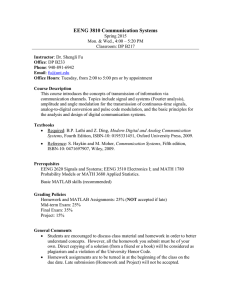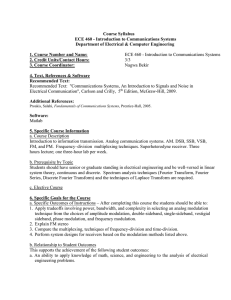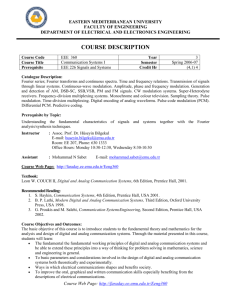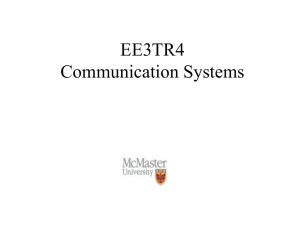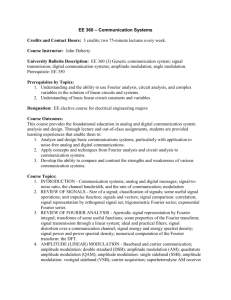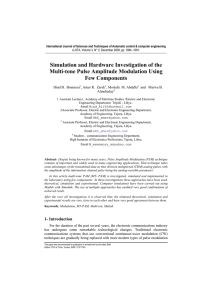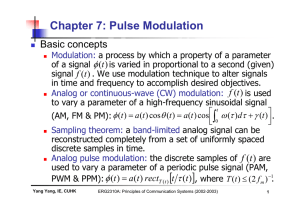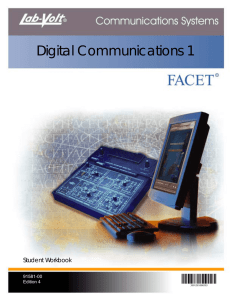Document 15905083
advertisement
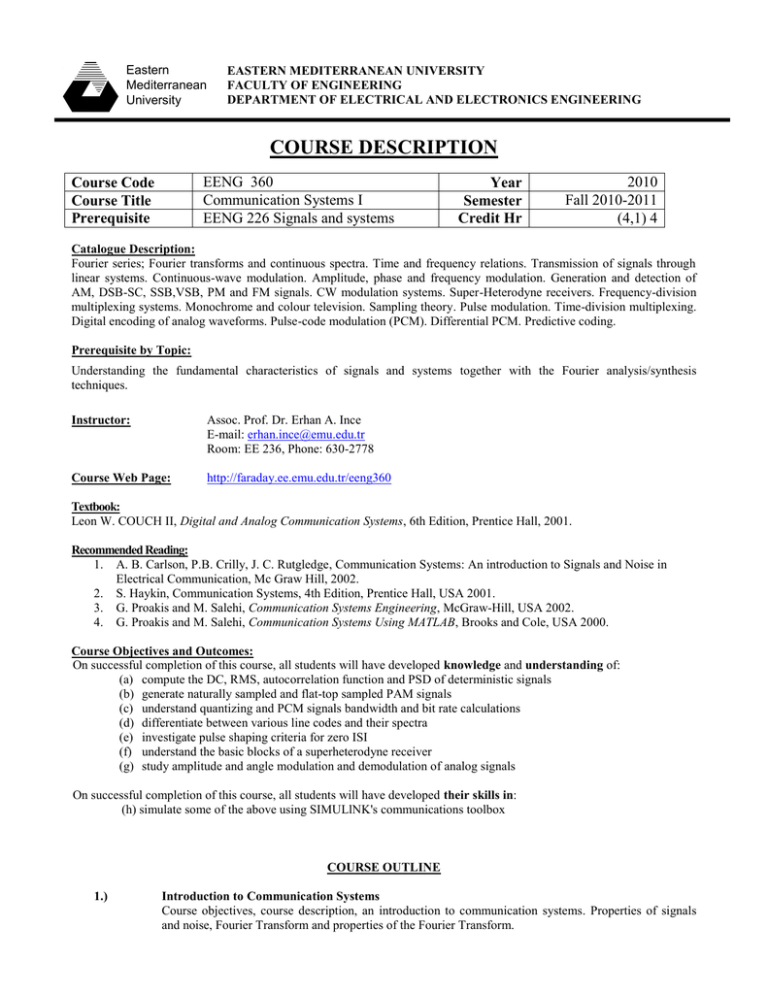
Eastern Mediterranean University EASTERN MEDITERRANEAN UNIVERSITY FACULTY OF ENGINEERING DEPARTMENT OF ELECTRICAL AND ELECTRONICS ENGINEERING COURSE DESCRIPTION EENG 360 Communication Systems I EENG 226 Signals and systems Course Code Course Title Prerequisite Year Semester Credit Hr 2010 Fall 2010-2011 (4,1) 4 Catalogue Description: Fourier series; Fourier transforms and continuous spectra. Time and frequency relations. Transmission of signals through linear systems. Continuous-wave modulation. Amplitude, phase and frequency modulation. Generation and detection of AM, DSB-SC, SSB,VSB, PM and FM signals. CW modulation systems. Super-Heterodyne receivers. Frequency-division multiplexing systems. Monochrome and colour television. Sampling theory. Pulse modulation. Time-division multiplexing. Digital encoding of analog waveforms. Pulse-code modulation (PCM). Differential PCM. Predictive coding. Prerequisite by Topic: Understanding the fundamental characteristics of signals and systems together with the Fourier analysis/synthesis techniques. Instructor: Assoc. Prof. Dr. Erhan A. Ince E-mail: erhan.ince@emu.edu.tr Room: EE 236, Phone: 630-2778 Course Web Page: http://faraday.ee.emu.edu.tr/eeng360 Textbook: Leon W. COUCH II, Digital and Analog Communication Systems, 6th Edition, Prentice Hall, 2001. Recommended Reading: 1. A. B. Carlson, P.B. Crilly, J. C. Rutgledge, Communication Systems: An introduction to Signals and Noise in Electrical Communication, Mc Graw Hill, 2002. 2. S. Haykin, Communication Systems, 4th Edition, Prentice Hall, USA 2001. 3. G. Proakis and M. Salehi, Communication Systems Engineering, McGraw-Hill, USA 2002. 4. G. Proakis and M. Salehi, Communication Systems Using MATLAB, Brooks and Cole, USA 2000. Course Objectives and Outcomes: On successful completion of this course, all students will have developed knowledge and understanding of: (a) compute the DC, RMS, autocorrelation function and PSD of deterministic signals (b) generate naturally sampled and flat-top sampled PAM signals (c) understand quantizing and PCM signals bandwidth and bit rate calculations (d) differentiate between various line codes and their spectra (e) investigate pulse shaping criteria for zero ISI (f) understand the basic blocks of a superheterodyne receiver (g) study amplitude and angle modulation and demodulation of analog signals On successful completion of this course, all students will have developed their skills in: (h) simulate some of the above using SIMULlNK's communications toolbox COURSE OUTLINE 1.) Introduction to Communication Systems Course objectives, course description, an introduction to communication systems. Properties of signals and noise, Fourier Transform and properties of the Fourier Transform. 2.) Signal Description and Properties Power spectral density and autocorrelation function, Fourier series expansion and linear systems. Bandlimited signals and the Sampling Theorem. Discrete Fourier Transform (DFT), bandwidth requirement of signals. 3.) Baseband Pulse Signalling and Pulse Code Modulation Pulse Amplitude Modulation (PAM) employing natural sampling and flat-top PAM. Reconstruction from PAM and equalization. Pulse Code Modulation (PCM): Sampling, quantizing and encoding, bandwidth requirement of PCM, quantization noise, binary line coding. 4.) Digital Signalling Line codes and their spectra, regenerative repeaters and bit synchronization. Inter-symbol Interference (ISI), Nyquist’s method for zero ISI and roll-off filtering. Time-division multiplexing (TDM) and TDM hierarchy, frame synchronization. 5.) Bandpass Signalling Principles Complex envelope representation of bandpass and modulated signals, spectrum and power of bandpass and modulated signals. 6.) Bandpass Signalling Circuits and Detectors Radio Frequency (RF) components: limiters, mixers, up and down converters, frequency multipliers, etc. Detector circuits: Envelope detector, product detector, frequency detector, PLL. Generalized transmitters and receivers: The superheterodyne principle. 7.) AM and FM Modulated Systems Amplitude modulation (AM), Double-Sideband Suppressed Carrier (DSBSC) and asymmetric sideband signals (SSB, VSB). Phase and frequency modulated signals (FM, PM). Laboratory/Studio Works: Laboratory sessions are organised in parallel to theoretical study given in classrooms. Students perform at least 8 different experiments and submit reports for evaluation Grading Policy: Midterm I Mıdterm II Final Examination Homeworks Laboratory 20% 20% 35% 5% 20% Makeup Exam & NG Policy: Only one make-up examination will be given to those who miss the midterm or the final. The student who wishes to take the make-up exam must provide a valid excuse within the next three working days. NG grade will be given to students who do not attend more than 80% of the course lecture and lab hours, and miss one exam. Contribution of Course to Criterion 5 Credit Hours for: Mathematics & Basic Science : 0 Engineering Design : 4 General Education : 0 Relationship of Course to Program Outcomes The course has been designed to contribute to the following program outcomes: (a) An ability to apply knowledge of mathematics, science, and engineering (e) An ability to identify , formulate and solve engineering problems (k) An ability to use the techniques, skills, and modern engineering tools necessary for engineering practice.
